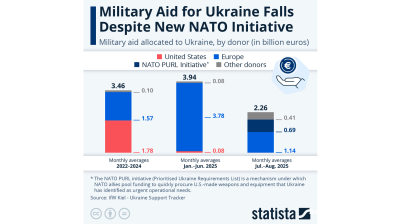A positive balance of payments will support the value of Ukraine’s currency, the hryvnia, largely thanks to $5bn worth of remittances sent home by Ukrainians working abroad, despite the swelling trade deficit. Indeed, Ukraine’s improving capital dynamics mean the hryvnia is already a top five global currency performer this year, but analysts say the currency will start weakening after the summer.
Ukraine just passed through its heaviest month of debt redemptions in May when it had to pay back some UAH41.8bn in borrowing that meant the country ran a small balance of payments deficits of $500mn that month.
At the same time the country spends more on imports than it makes from exports. The trade balance deficit was $3.2bn in the first half of this year. Exports swelled by 7.4% in the first quarter to $12.5bn, while goods imports grew slightly more quickly, up by 7.9% to $13.7bn.
The pressure on the trade deficit has eased somewhat thanks to the swelling volumes of grain exports. Ukraine became the world leader in grain exports in the agricultural marketing season that ended on June 30, overtaking Russia to become the world’s number one, after it exported a record 50mn tonnes to earn some $20bn. Grain exports surged 52% y/y and finished food product exports picked up 18.3% y/y in June. However, the trade account is still operating at a loss. A slow recovery in incomes is sucking in more imports and that will remain a problem as Ukraine’s recovery gathers pace.
But despite the trade deficit the current account – a broader measure of the ebb and flow of capital coming into the country that includes investment and remittances – was positive in May at $249mn, after being in deficit for most of last year.
Several factors contributed to the positive current account surplus, including a €1bn Eurobond the government issued in June that covered much of its debt repayments that month. That bond has since been followed by a $500mn Eurobond issued at the start of July by the state-owned Ukrzaliznytsia (Ukrainian Railway). On top of the Eurobonds, the local bond market is flying after it was hooked up to the Clearstream international payments and settlements system and has already attracted $2bn of investment from non-residential investors, who have been snapping up the high yielding hryvnia denominated bonds. Foreign bond investors already own just over 7% of the total outstanding bonds, from next to nothing last year.
But by far the biggest factor pushing the current account into the black is remittances. About 10mn Ukrainians have taken advantage of the visa-free deal with the EU cut by former president Petro Poroshenko to look for work in the west. At the same time Ukraine’s near neighbours – especially Poland – have taken advantage of this mobile workforce to meet the growing labour shortage crisis in Central Europe following several years of booming growth, and have offered Ukrainians easy to get temporary work permits.
The upshot is these workers sent home $5.1bn in the first half of this year that fully covered the widening trade deficit and then some.
The surplus from the bond issues and remittance inflows can be seen in the gross international reserves (GIR) which increased by 6.4% in June y/y, according to preliminary data, to $20.639bn and is now a more comfortable three months of import cover equivalent – the minimum economists believe is needed to ensure the stability of a national currency.
With remittances running at about $10bn-11bn a year Ukraine is likely to collect the same amount in the second quarter as it did in the first, which will continue to cover the trade deficit and contribute to the debt redemptions.
“The fundamental situation remains favourable for further UAHFX rate strengthening and accumulation of international reserves, which rose by $1.4bn in June, mainly due to the issuance of Eurobonds and the non-resident portfolio inflows to the UAH bond market,” Oleksandr Sukhomlyn of Raiffeisen Bank Aval in Kyiv said in a note.
Ukraine’s improving fundamentals have bolstered the currency, which is now the fourth best performer against US dollar so far in 2019, according to Bloomberg.
Ukraine’s national currency advanced around 5.5% against the dollar during the first half of 2019, with gains of 2.5% in the month of June alone.
And the rising value of the hryvnia creates a virtuous circle as it makes the hryvnia-denominated bonds more valuable, in addition to the high yields they already pay. That in turn sucks in more foreign investment into the local bond market, which again increases the value of the currency as the circle turns.
Non-resident investments in Ukrainian bonds have already soared over nine-fold since the start of the year and while the Ministry of Finance is staring to slow the accumulation, but using the demand to squeeze the yields it has to pay on the bonds lower, the growth of the local bond market will make meeting its debt redemptions easier and that in turn will also have a positive effect on the currency as the level of indebtedness falls.
Here too there has already been progress. Ukraine’s state and state-guaranteed debt declined 1.8% m/m to $78.4bn in May, the finance ministry reported on June 26. And the state debt is now the equivalent of 54% of Ukraine’s 2018 GDP – a relatively modest level by international standards.
Analysts at Concorde Capital estimate that the state debt will grow to $80.8bn in 2019, or around 56% of GDP, as the government issues more bonds to refinance old debt. But this is not a problem as not only does the overall level of debt remain modest, the yields the government can command are already falling, making servicing this debt easier. June’s sovereign Eurobond got away with a yield of 6.75% to very high demand – less than the 7% analysts were expecting in the run up to the issue.
All-in-all Ukraine’s Ministry of Finance is planning a total of $4.2bn of foreign borrowing this year in a prudent debt programme that it is well on track to meet, although the resumption of the International Monetary Fund (IMF) stand-by arrangement (SBA) programme and receiving the two tranches of $1.9bn remain crucial to this programme. Talks with the IMF have been temporarily suspended until July’s general election is passed, but Ukrainian President Volodymyr Zelenskiy said recently that maintaining the commitment to the IMF programme is a core part of his policy.
“Over the next four years, the hryvnia will gradually devalue against the dollar, moving from UAH27/$1 today, to almost UAH31/$1 in 2022,’ says SP Advisors in Ukraine.
The projection is part of the government’s debt management strategy adopted in June by the cabinet of ministers. In February 2016, the exchange rate hit UAH27/$1. Since then, it has varied within a narrow band.
According to the government forecast, the US dollar will cost: UAH28 at the end of this year; UAH29.4 in 2020; UAH30.5 in 2021; and UAH30.7 in 2022, reports SP Advisors.
The outlook for the currency is further muddied by the uncertainties surrounding restarting the IMF deal. But even if the IMF deal continues the local currency is still expected to weaken in the autumn.
“The weakening season should start in 2H19, when pressure on the hryvnia will rise from higher demand for $from importers and FX dividend payers. We expect UAH to soften to UAH27/$by August, and further to UAH28.5/$by YE2019. Rising demand from foreign investors for government UAH paper may cause the hryvnia to outperform our forecasts. On the other hand, we think that downside risks for the national currency are higher due to possible delays in the IMF deal, fragile investor sentiment, and a possible rise in FX dividend repatriation from Ukraine,” the Kyiv-based investment bank ICU said in a note on June 9.
-
This article is from  bne IntelliNews' Ukraine monthly country report. Sign up to receive the report to your inbox each month, covering the slow moving macro- and micro-economic trends, the major political news and a roundup of the main sectors and corporate news. The first month is free and you can unsubscribe at any time.
bne IntelliNews' Ukraine monthly country report. Sign up to receive the report to your inbox each month, covering the slow moving macro- and micro-economic trends, the major political news and a roundup of the main sectors and corporate news. The first month is free and you can unsubscribe at any time.
See a sample here.
Subscribe here (first month is free and you can unsubscribe at any time)
Or ask bne IntelliNews’s Stephen Vanson for a trial and corporate packages.
The report covers:
- macroeconomic trends and the real sector
- banking and finance
- public and external sector
- sector and leading corporate news
Or sign up for a trial by simply clicking on the button below. The first month is free and you can unsubscribe at any time by sending an email to sales@intellinews.com
Sample:
http://online.flipbuilder.com/myab/dopo/
Order form:
https://to989.infusionsoft.com/app/orderForms/SUBOF-Country-Report-Ukraine-monthly
Features

BEYOND THE BOSPORUS: Investigators feel collar of former Turkish central bank deputy governor
Regime gangs continue to hustle for gains. Some Erdoganist businessmen among the losers.

Journalist beaten to death in Istanbul as security conditions in Turkey rapidly deteriorate
Publisher, meanwhile, is shot in leg. Reporters regularly experience violence, judicial harassment and media lynching.

Agentic AI becomes South Korea’s next big tech battleground
As countries race to define their roles in the AI era, South Korea's tech giants are now embracing “agentic AI”, a next-generation form of AI that acts autonomously to complete goals, not just respond to commands.

Iran's capital Tehran showcases new "Virgin Mary" Metro station
Tehran's new Maryam metro station honours Virgin Mary with architecture blending Armenian and Iranian design elements in new push by Islamic Republic




